In this thesis, the 51 arable weed species and 3 weed genera that are most common in Germany were reviewed for their provision of food and shelter for the fauna. Direct and indirect linkages between weeds and birds as well as phytophagous arthropods, agricultural pest arthropods, natural enemies and pollinators were counted based on data from published literature. A total of 5180 linkages was counted, of which 92 arthropod species were monophagous. Based on this, several weed species of particularly high biodiversity value were identified. The highest number of linkages with arthropods was found for Rumex acetosella, Cirsium arvense and Taraxacum officinale. For birds, Rumex officinalis, Raphanus raphanistra, Stellaria media, Spergula arvensis, Chenopodium album and the Polygonaceae genus were found to be key food items.
Where have all the flowers gone? The intensification of agriculture, with its more efficient weed control methods, has led to significant changes in agroecosystems. Since 1950, the biodiversity of arable weeds in crops has sunk by more than 70%. At the same time, arthropods and birds have been in steep decline across all taxa in Germany and beyond. The global biodiversity loss is occurring at an alarming rate, but what is the role of arable weeds in supporting biodiversity? And how can the knowledge of the ecological value of arable weeds be integrated into practical farming?
Today, weeds are mainly regarded as economically damaging. The data from this thesis and a number of other studies indicate that a new approach to weed management is needed. Weeds do much more than impede crop production, as they support a wide range of ecosystem services.
A model that takes the benefits of weeds both for biodiversity and farmers into account should be developed urgently. Several management suggestions are briefly reviewed here, but it will need a broad discussion among all stakeholders to bring about much-needed change in practical weed management and farming.
Inhaltsverzeichnis (Table of Contents)
- Abstract
- List of Tables
- List of Figures
- 1. Introduction
- 1.1 Weeds: their significance and population trend
- 1.2 Biodiversity trends of arthropods and birds
- 1.3 Weeds as ecological goods
- 1.4 Research objectives
- 2. Material & Methods
- 3. Results
- 4. Discussion
- 4.1 Identifying key weed species
- 4.2 Balancing biodiversity and crop production
- 4.3 Managing weeds for biodiversity
- 4.4 Conclusions and outlook
- Cited literature
- Acknowledgements
Zielsetzung und Themenschwerpunkte (Objectives and Key Themes)
This thesis investigates the role of common arable weeds in supporting biodiversity in Germany. It examines the impact of intensive agriculture on weed populations and explores the ecological value of weeds for arthropods and birds. The research aims to identify key weed species that contribute significantly to biodiversity and to propose practical management strategies that balance biodiversity conservation with crop production.
- The decline of arable weed biodiversity in Germany due to intensive agricultural practices
- The ecological value of weeds as food and shelter for arthropods and birds
- Identifying key weed species with high biodiversity value
- The importance of integrating biodiversity considerations into weed management practices
- The need for a new approach to weed management that balances biodiversity and crop production
Zusammenfassung der Kapitel (Chapter Summaries)
The introduction provides a background on the significance of weeds in agroecosystems and discusses the trends in biodiversity loss for both weeds and other organisms. It also highlights the ecological goods provided by weeds and outlines the research objectives. The "Material & Methods" chapter explains the methodology used for reviewing weed species and analyzing their relationships with fauna. The "Results" chapter presents data on the number of linkages between weed species and different groups of arthropods and birds, highlighting key weed species with high biodiversity value. The "Discussion" chapter delves into the implications of these findings for weed management, emphasizing the need for a balanced approach that considers both biodiversity and crop production. It also explores potential solutions for managing weeds to support biodiversity.
Schlüsselwörter (Keywords)
The main keywords and focus topics of this thesis are: arable weeds, biodiversity, arthropods, birds, ecosystem services, weed management, sustainable agriculture, biodiversity conservation, crop production.
- Citation du texte
- Naomi Sarah Bosch (Auteur), 2020, How common arable weeds in Germany support the biodiversity of arthropods and birds, Munich, GRIN Verlag, https://www.grin.com/document/948406



